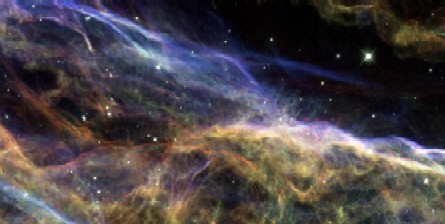Colors of the Universe

It's not all black and white.

The Veil Nebula shows off its brilliant colors.
Blue Planets
Earth, Neptune, and Uranus are all blue because of gases in their atmosphere.

The big and very blue planet Neptune.
Blue Stars
These are the hottest stars, with a surface temperature of more than 37,000°F.

The Seven Sisters, also known as the Pleiades star cluster, are located more than 400 light-years away in the Taurus constellation. Clouds of dust sweep around the stars, swaddling them in a cushiony veil. One of the parent stars, Atlas, can be seen at the bottom, while six of the sisters are visible at top. Additional stars in the cluster are sprinkled throughout the picture in blue.
Yellow Stars
These are warm stars, such as the Sun. Their temperature is about 10,000°F.

Coronal loops on the surface of the Sun, a warm yellow star.
Red Stars
The coolest stars are red. Their surface temperature is less than 5,500°F.

Red stars located in the constellation of Cepheus at a distance of 2,450 light-years.
Red Shift
When light coming from a distant star is seen through a spectroscope (an instrument that separates light into its different colors), the light we receive continues to shift toward the red area of the spectrum, which is the least powerful. This means that, since the light is becoming weaker and weaker, the stars must be traveling away from us. This makes scientists believe that our universe is expanding.

The Andromeda Galaxy viewed through visible (bottom left) and infrared light (top and bottom right).
Red Spot
A swirling cloud on the planet Jupiter is a raging storm of gases, mainly red phosphorus.

Jupiter's Giant Red Spot next to the newly nicknamed Red Spot Junior, a massive anticyclone (high pressure system)
